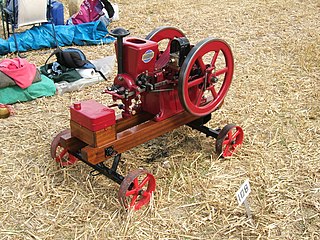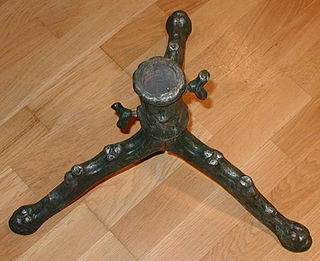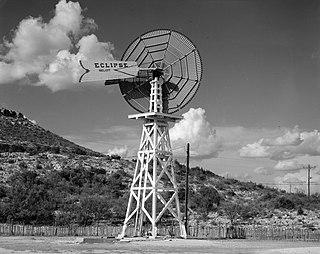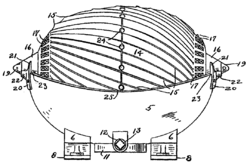
A tractor is an engineering vehicle specifically designed to deliver a high tractive effort at slow speeds, for the purposes of hauling a trailer or machinery such as that used in agriculture, mining or construction. Most commonly, the term is used to describe a farm vehicle that provides the power and traction to mechanize agricultural tasks, especially tillage, and now many more. Agricultural implements may be towed behind or mounted on the tractor, and the tractor may also provide a source of power if the implement is mechanised.

Deere & Company, doing business as John Deere, is an American corporation that manufactures agricultural machinery, heavy equipment, forestry machinery, diesel engines, drivetrains used in heavy equipment, and lawn care equipment. It also provides financial services and other related activities.

A toy soldier is a miniature figurine that represents a soldier. The term applies to depictions of uniformed military personnel from all eras, and includes knights, cowboys, American Indians, pirates, samurai, and other subjects that involve combat-related themes. Toy soldiers vary from simple playthings to highly realistic and detailed models. The latter are of more recent development and are sometimes called model figures to distinguish them from traditional toy soldiers. Larger scale toys such as dolls and action figures may come in military uniforms, but they are not generally considered toy soldiers.

A velocipede is a human-powered land vehicle with one or more wheels. The most common type of velocipede today is the bicycle.

In horology, a tourbillon is an addition to the mechanics of a watch escapement to increase accuracy. Conceived by the British watchmaker and inventor John Arnold, it was developed by his friend the Swiss-French watchmaker Abraham-Louis Breguet and patented by Breguet on 26 June 1801. In a tourbillon the escapement and balance wheel are mounted in a rotating cage, with the goal of eliminating errors of poise in the balance giving a uniform weight.

The Regency TR-1 was the first commercially manufactured transistor radio, introduced in 1954. Despite mediocre performance, about 150,000 units were sold, due to the novelty of its small size and portability. Previously, transistors had only been used in military or industrial applications, and the TR-1 demonstrated their utility for consumer electronics, offering a prescient glimpse of a future full of small, convenient hand-held devices that would develop into calculators, mobile phones, tablets and the like. Surviving specimens are sought out by collectors.

Aaron Willard was an entrepreneur, an industrialist, and a designer of clocks who worked extensively at his Roxbury, Massachusetts, factory during the early years of the United States of America.

A hit-and-miss engine or Hit 'N' Miss is a type of stationary internal combustion engine that is controlled by a governor to only fire at a set speed. They are usually 4-stroke but 2-stroke versions were made. It was conceived in the late 19th century and produced by various companies from the 1890s through approximately the 1940s. The name comes from the speed control on these engines: they fire ("hit") only when operating at or below a set speed, and cycle without firing ("miss") when they exceed their set speed. This is as compared to the "throttle governed" method of speed control. The sound made when the engine is running without a load is a distinctive "Snort POP whoosh whoosh whoosh whoosh snort POP" as the engine fires and then coasts until the speed decreases and it fires again to maintain its average speed. The snorting is caused by the atmospheric intake valve used on many of these engines.

Two-wheel tractor or walking tractor are generic terms understood in the US and in parts of Europe to represent a single-axle tractor, which is a tractor with one axle, self-powered and self-propelled, which can pull and power various farm implements such as a trailer, cultivator or harrow, a plough, or various seeders and harvesters. The operator usually walks behind it or rides the implement being towed. Similar terms are mistakenly applied to the household rotary tiller or power tiller; although these may be wheeled and/or self-propelled, they are not tailored for towing implements. A two-wheeled tractor specializes in pulling any of numerous types of implements, whereas rotary tillers specialize in soil tillage with their dedicated digging tools. This article concerns two-wheeled tractors as distinguished from such tillers.
Belt Pulley was a U.S.-based magazine dedicated to antique farm tractors of all brands and makes. It published successfully for over 2 decades and was one of the best known titles in the category. It was a family business run first by the Aumann family and then by the Elmore family. In 2009 it was sold, and the new owner eventually changed the name of the publication to Vintage Tractor Digest. This ended its publication under the Belt Pulley title.

The Oliver Farm Equipment Company was an American farm equipment manufacturer from the 20th century. It was formed as a result of a 1929 merger of four companies: the American Seeding Machine Company of Richmond, Indiana; Oliver Chilled Plow Works of South Bend, Indiana; Hart-Parr Tractor Company of Charles City, Iowa; and Nichols and Shepard Company of Battle Creek, Michigan.
Roths Industries, Inc. (1945–1960) was a manufacturer of small garden tractors and other agricultural equipment founded by Herbert C. Roths in Alma, Michigan. The company manufactured Garden King Walking Tractors, BesRo Riding Tractors, and Till Ro Stalk Cutters.

A Christmas tree stand is an object designed to support a cut, natural or an artificial Christmas tree. Christmas tree stands appeared as early as 1876 and have had various designs over the years. Those stands designed for natural trees have a water-well, which, in many cases may not hold enough water to adequately supply the cut tree. Some specialty Christmas tree stands have value on the secondary antiques market.

A bisque doll or porcelain doll is a doll made partially or wholly out of bisque or biscuit porcelain. Bisque dolls are characterized by their realistic, skin-like matte finish. They had their peak of popularity between 1860 and 1900 with French and German dolls. Bisque dolls are collectible, and antique dolls can be worth thousands of dollars. Antique German and French bisque dolls from the 19th century were often made as children's playthings, but contemporary bisque dolls are predominantly made directly for the collectors market.
An Antique toy show is one of several toy shows held throughout the United States, usually on an annual basis, that is devoted to the exhibition, for sale, of antique toys, dolls and collectible paraphernalia. Toy shows are generally regional in nature, and cater to a certain geographic area of the country. The larger shows, such as the Miami Antique Toy Show and the Chicago Toy Show and the Greater Boston Antique and Collectible Toy Show encompass a broader clientele.

Heritage Iron Magazine was founded in 2008 for those interested in muscle tractors. Muscle Tractors are a classification of tractors specifically produced from the 1960s to the mid-1980s that feature turbo, duals, and front wheel assist. Muscle tractors were a turning point in American farm mechanization when horsepower was taking over from steel wheels and crank-start tractors. This generation of tractors has been growing in popularity among tractor collectors. The magazine was founded to satiate the heritage farmer’s appetite. Heritage Iron features all brands, all makes, and all models of muscle tractors from the 1960s to mid 1980s including the equipment that the tractors used. It is published out of Greenville, Illinois, by 3-Point Ink, LLC.

William P. Bettendorf was a German-American inventor. He is credited with the invention of the power lift sulky plow, the Bettendorf metal wheel and the one-piece railroad truck frame. By the age of 53 he held 94 patents. With his younger brother, Joseph W. Bettendorf, he founded the Bettendorf Axle Company. His first wife and children preceded him in death. He died as the company was rapidly expanding and before he moved into a palatial home he was building. The city of Bettendorf, Iowa is named after the two brothers.

The Eclipse windmill was one of the more successful designs of windmill used to pump water in the nineteenth century United States. It was invented by Leonard Wheeler, a Presbyterian minister who was working among the Ojibwe on the south shore of Lake Superior. Wheeler perfected the device on his missionary homestead over nearly two decades, unknown to the larger technological world. In 1866 health issues forced him to move to Beloit, Wisconsin, then a bustling industrial city, where he was persuaded to patent the basic function of the device. Although Wheeler died before he could witness the success of his invention, his sons carried on the legacy. Some of the companies that succeeded the original Eclipse Windmill Company remain viable in the 21st century.

Griswold Manufacturing was an American manufacturer of cast iron kitchen products founded in Erie, Pennsylvania, in business from 1865 through 1957. For many years the company had a world-wide reputation for high-quality cast-iron cookware. Today, Griswold pieces are collectors' items.

The firm of T. Norris & Son was one of the most prestigious makers of hand tools in England in the late nineteenth and early twentieth centuries and famed for the quality and gracefulness of its output, notably of its metal planes. Both wooden and metal planes made in Norris's workshop survive as do other edge tools. Some Norris planes, especially bespoke models, are highly prized by woodworkers and collectors.



















